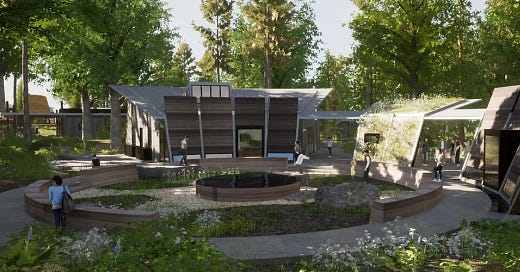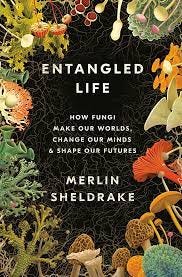Refugia Newsletter #40
Fossil fuel tipping points, a bunch of wonderfully icky things, and a faith-based refugium in Puget Sound
Refugia News
Whew! I turned in my grades earlier this week and the 2022-23 academic year is officially over—at least the teaching part. Oh there’s work to be done this summer, plenty of work. I’ll be revising a conference paper and preparing for five courses next year and going to meetings and doing a LOT of reading. But I always feel a sense of relief when the daily deadlines of teaching and grading are safely behind me—for a little while anyway.
I’m taking a little time off this summer from refugia-related speaking engagements, but first there’s one more coming up soon. You are very welcome to join me and the good people of the Circlewood community for this conversation/webinar on May 24 at 7 pm Pacific time. Check out the Refugia Sighting below for a mini-interview with Circlewood executive director James Amadon.
Before we head into today’s news, a quick follow-up on the Earth Day edition last time. If you missed Rev. Antal’s compelling speech, the folks at Third Act have provided a handy place to find the recording and a transcript. Thanks, friends!
This Week in Climate News
Two stories today: the ongoing struggle to reshape the legal landscape to address climate damages and a possible tipping point for fossil fuels.
First: legal news. Here’s the lede from an article by Emma Ricketts of Inside Climate News:
The Supreme Court on Monday [April 24] declined to hear five appeals from the fossil fuel industry seeking to move climate change lawsuits it faces to the federal courts. The decision opens the door for Baltimore and other cities, states and counties to pursue their claims for damages from climate-related extreme weather events, flooding and sea-level rise in state courts.
Why does this matter? Because it’s easier for fossil fuel companies to fight these lawsuits in federal court. If it’s possible for states and localities to sue for particular damages to their particular regions, the fossil fuel industry will be tied up in a thousand lawsuits all over the country for the foreseeable future. They would much rather squash it all with one federal ruling.
It’s interesting to me that the quotes from fossil fuel reps in this article are all efforts to change the subject, basically. “But this isn’t the way to fight climate change!” they protest. That’s not the point. The point of the lawsuits is past behavior, not future behavior. The fossil fuel companies knew their product causes damages but deliberately deceived the public about that knowledge, making billions of dollars in the process. (Exxon announced 2023 first-quarter profits of $11.4 billion, just as an example.) This recent US Supreme Court ruling could become one small piece of a global movement toward establishing legal tools for holding these companies responsible.
Speaking of deception, here’s your vocab word for the day: paltering. Paltering is a nifty term for “using statements that are technically true, but also leave out critical information in order to mislead people,” according to climate writer Amy Westervelt. Here’s an article that explains the history of the term. So when fossil fuels companies say “We’re investing millions on solutions!” that may be technically true, but it’s also true that they’ve investing billions, daily, in continuing to cause the problem.
Next: is it possible we have reached a good tipping point toward renewables?
The independent think tank Ember announced that their data suggests “2022 is likely to mark a ‘turning point’ when global fossil fuel electricity generation peaked and began to fall.” (This from a summative article by Josh Gabbattis in Carbon Brief.)
The best way to explain this is to show you a graph from the Ember report:
Note that 2022 still marked an increase in electricity generation from fossil fuels (1.3%). And, in fact, thanks to rapid electrification, the demand for electricity will continue to increase, as the chart shows. However, since renewables are building out so quickly right now, they are set to outpace the demand increase and thus suppress demand for fossil fuels.
Deeper Dive
OK, let’s have some fun with icky (but really cool) things! Prepare for a lovely stew of ickiness.
I’ve been reading Entangled Life: How Fungi Make Our World, Change Our Minds, & Shape Our Futures by the mycologist Merlin Sheldrake. (Thanks to my friend Mary Timmer for giving me the book.) Wowza, fungi are cool! They basically rule the universe; life is not possible without them. At all.
Fungi are fascinatingly complex. For instance, you might know that lichens are combinations of fungi and algae. Well, turns out it’s not that simple.
“Lichens are places where an organism unravels into an ecosystem and where an ecosystem congeals into an organism. They flicker between ‘wholes’ and ‘collections of parts.’ … Lichens are the product less of their parts than of the exchanges between those parts. Lichens are stabilized networks of relationships; they never stop lichenizing; they are verbs as well as nouns.”
And in fact, all life is a matter of shimmering interrelationship. Once you start learning about life on the microbial level, our basic concepts of species, autonomy, individuality start to seem clunky and inadequate.
The book is a dense but fascinating read. Mind-blowing. I keep thinking of Aldo Leopold’s dictum, “If the land mechanism as a whole is good then every part is good, whether we understand it or not… To keep every cog and wheel is the first precaution of intelligent tinkering.” Turns out there are a lot of teeny-tiny cogs and wheels.
Next: did you hear about the “seaweed blobs” off the Atlantic coast? The seaweed is called “sargassum,” another fun vocab word. On April 19, the New York Times reported,
“Tangles of the goopy, leafy seaweed have already begun to wash ashore beaches in southern Florida and Mexico. In the coming months, they could start emitting a rotting stench as they decay, potentially posing health risks to beachgoers.”
Yuck! It happens every year, but this year is especially bad. Here’s a map. (For more detail and maps, you can check out the NASA website.)
Image credit: New York Times
Next: Maybe Floridians could make all that seaweed into bacon. Yes, seaweed bacon is a thing. It has been developed by a company called Umaro, and it’s already in restaurants. Well, certain restaurants. I can’t vouch for the stuff. Anyone tried it?
Image credit: Umarofoods.com
Next: Michigan’s Lake Erie and icky algal blooms.
You may know that Lake Erie has been plagued with problems for many decades. It all goes back to mid-nineteenth-century efforts to drain wetlands for farming in Eastern Michigan. Wetlands were thought to be, I suppose, icky and useless. Turns out wetlands are essential: they serve as the lake’s kidneys, and without them, real ick ensues from industrial and agricultural runoff that poisons the lake. So last fall, Michigan birding, hunting, and fishing groups got together to push for recreating wetlands in Eastern Michigan, using $30 million in American Rescue Plan money.
Pointe Mouillee State Game Area. Image credit: Lester Graham/Michigan Radio
Next, we take a religious turn.
Since we are “holobionts”—that is, walking ecosystems swarming with microbes—then what does that mean for the doctrine of the resurrected Jesus? Was Jesus’ gut biome also resurrected?
Possibly not a theological question you have pondered, but some people have. Melissa Florer-Bixler, in the Easter issue of The Christian Century, concludes that yes, we’re talking resurrected microbes:
Are the other creatures that make up Jesus also resurrected on the third day? It would seem so. Jesus is made up of organisms that live and die for and within the community of his body. His resurrection is the first fruit of our creaturely intimacies.
Ponder that one until Pentecost.
Finally, get out the tissues.
Apparently climate change makes allergies worse, so prepare for a lot more snot. According to an article in The Atlantic by Yasmin Tayag, “Our climate future will be very sneezy.”
The problem is not just that higher temperatures lengthen plants’ growing season; carbon dioxide itself encourages pollen production. Compared with three decades ago, the North American pollen season now starts about 20 days earlier, lasts roughly eight days longer, and involves 21 percent more pollen, according to research published in the journal PNAS.
Refugia Sighting
I’m delighted to share with you today a mini-interview (as promised above) with James Amadon, Executive Director of Circlewood. Circlewood is “a community of people committed to cultivating a more ecologically-conscious faith.” In other words, they are a refugium, quite literally in fact.
Their home base is a 40-acre forest on Camano Island in Puget Sound. That’s where they’re working to build a “village” where faith leaders can come to learn more about “how to live in more harmony with each other and the earth.” As they work on the village, they are busy providing educational resources and making relationships—such as the online conversation on Refugia Faith on May 24. I’m grateful to my friend Kyle Small for introducing me to Circlewood, and very grateful to James for taking the time to respond to my questions.
Circlewood’s mission is “to accelerate the greening of faith.” You are doing this with the village and with educational resources like a podcast, an online journal, workshops and courses, and online events. Why is the place itself important in your mission?
We are in a period of rapid ecological change affecting every place and people group on Earth. While emerging political, corporate, and technological solutions are promising, we cannot depend on the same frameworks and tools that helped create this crisis to get us out of it. Changing course will require a major transformation of humanity’s worldview and way of life – a cultural, moral, and spiritual task that is often called “The Great Work” of this new millennium. To guide and accelerate this Great Work, we need places that demonstrate what it means to live in harmony with the earth, places that enable destructive patterns and ways of thinking to unravel and reform, places that help us rediscover ancient wisdom and practices, places that unlock and unleash humanity’s creative capacities for change. We need places that call people into the Great Work and help it move a little faster, places that, in the language of Circlewood Village, “accelerate the greening of humanity.”
What are three important ways that you believe the “greening of faith” could happen in the next 20 years?
Theological transformation. Recovering of a more ecologically-conscious faith is happening across denominational lines, geographical borders, and people groups. Followers of Jesus are discovering/recovering ecotheological resources from Christian history and tradition, as well as from within their own particular traditions. In addition, new resources for ecotheology are multiplying rapidly. My hope is that in 20 years this theological understanding will be the norm.
Missional Imagination and Integration. It is important that congregations journey towards a more integrated sense of mission in which evangelism, works of mercy and justice, and care for the earth are woven together as our part to play in God’s work of new creation. This will require reimagining core congregational practices. Imagine a church that invites people to know God through creation, worships God with creation, understands that human needs cannot be divorced from the needs of other creatures, and brings people together to serve their local watershed. This is, I believe, a key to the Church’s revitalization over the next 20 years.
It is important that congregations journey towards a more integrated sense of mission
in which evangelism, works of mercy and justice, and care for the earth are woven together
as our part to play in God’s work of new creation. This will require reimagining core congregational practices.
Creative partnerships. In times of crisis, people can respond with fear or courage. They can focus their energy either on building walls to protect what is theirs, or on reaching out to form new friendships, alliances, and partnerships. People of faith have an opportunity to come together around our planetary crisis, to meet fellow followers of Jesus (and fellow earthkeepers) with arms and minds open wide. This not only creates the conditions for creative and unifying work, it can also be energizing, hopeful, and joyful.
What do you hope faith leaders who work with you will bring back to their faith communities?
Leading faith communities is hard, especially when it is necessary to break the status quo, strike out in a new direction, and re-form the community as it journeys together. We want faith leaders to come away from their time with Circlewood knowing they are not alone, that there are ways to lead faith communities toward a more faithful, just, and sustainable future, and that, though the challenge before us is great, it is an exciting time to be a follower of Jesus!
The vision for the Village. Image credit: circlewood.online
The Wayback Machine
That’s plenty for today. I’ll end with this wayback photo of me with Leo and Maizey. Leo (the ginger) lived his adventurous life with my in-laws. Our beloved Maizey-dog (the blondie) lived a long and happy life (15 years!), but passed away on Feb. 4. We miss her!
Until next time, be well.












Love the policy practicality of this newsletter--and its wondrous quirky enthusiasm!